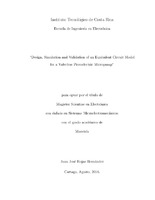Design, simulation and validation of an equivalent circuit model for a valveless piezoelectric micropump
Resumen
Equivalent electric circuit models are commonly used in microfluidics to represent
the dynamic behavior of fluidic components in terms of their equivalent electric
counterparts.
FEM simulation tools are widely used for solving complicated problems, usually
involving coupled physics.
In this work a hybrid electric circuit model –HECM– and a complete FEM simulation
are used to characterize a piezoelectric valveless micropump –PVM–. The model
is considered hybrid because the parameters of the lumped elements are obtained
using analytic solutions or FEM simulations depending of each case.
Results of those two approaches – HECM and FEM simulations– are compared to
experimental results obtained from the fabrication of a number of equal prototypes.
The prototypes are fabricated using a technique called GAG –glass adhesive glass–
which uses a combination of glass and adhesive layers to create a flow path.
The HECM was 5 times faster in obtaining the required results and it was more
accurate to describe the behavior of the PVM.
Descripción
Proyecto de Graduación (Maestría en Electrónica) Instituto Tecnológico de Costa Rica, Escuela de Ingeniería Electrónica, 2016.


